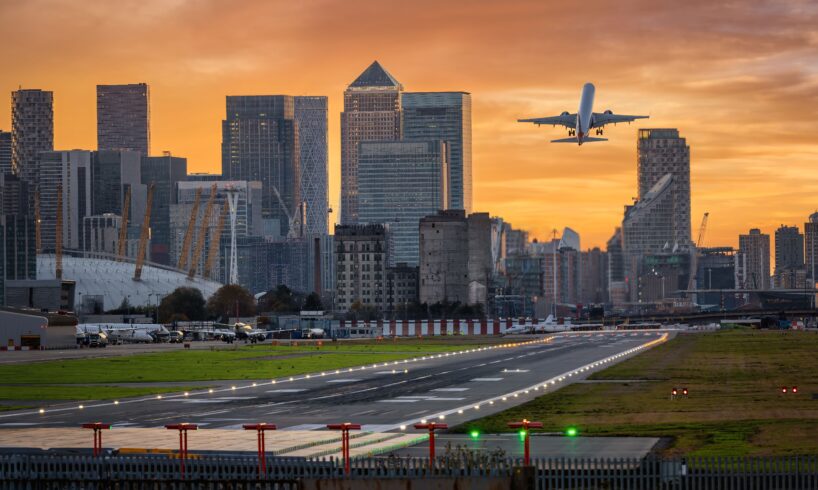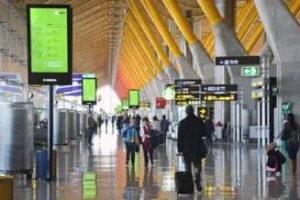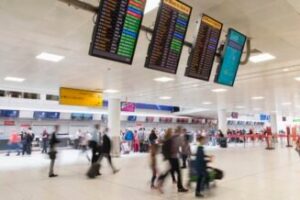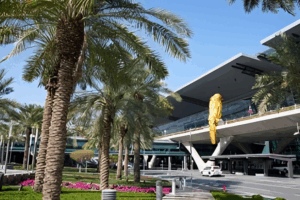
The length of a Runway
is a factor that affects many aspects of airport operation, greatly impacting how the aviation industry is able to operate in an area. Runways can be long or short, rough or smooth, and these aspects can limit the type of aircraft that can land or take off. As a result, runways have a direct impact on the amount and type of resources and goods that can be transported to or from an area by air.
To get a better idea of what the aviation industry looks like in the UK, this article will review the shortest runways, identifying the shortest commercial and private runways.
Which Is The Shortest Commercial Runway?
Photo: Sven Hansche | Shutterstock
Commercial airports in the United Kingdom are registered with and overseen by the UK Civil Aviation Authority (CAA), which grants Public Use Aerodrome Licenses to commercial airports. The shortest commercial runway in the UK which operates non-subsidized commercial scheduled flights is London city airport
(LCY). There are shorter runways in the UK, which will be covered a little later, but in terms of strictly commercial airports, London City takes it.
The single runway at London City Airport is 4,928 ft long. Nestled among the crowded London skyline, which is full of tall buildings, larger aircraft must take steep ascent and descent paths in order to take off or land there. A recent article about the airport covered how the Embraer E195-E2 is now the largest aircraft capable of using the runway. This was only possible thanks to the use of automated control features, which ensure the aircraft takes the correct steep flight path during ascent and descent.
The airport has also embraced other technologies, streamlining operations on the compact site. In 2021, LCY became the first major international airport in the world to be fully controlled by a remote digital air traffic control tower, according to Nats Aero. Air traffic controllers operate 115km away at NATS’ air traffic control center in Swanwick, Hampshire, using an ‘enhanced reality’ view. This digital control tower replaced the original one, which opened with the airport in 1987.
Why London City Airport Attracts Business
Photo: William Perugini | Shutterstock
London City Airport is located more centrally in the large city than the main London airport, London Heathrow Airport
. Anyone who has traveled around London knows that making the trip from one side of the city to the other can be an ordeal. As the most convenient and inexpensive way is via the noisy, complicated, and sometimes crowded London Tube underground train network, LCY, being accessible from the financial heart of the city, is very convenient for passengers traveling via Europe.
For those traveling to and around London, one of the most considerable inconveniences is the number of regulations imposed in the area, and in keeping with that London trend, LCY is also subjected to more regulations than normal, having strict noise regulations imposed on it, along with climate impositions, and approach angle training prerequisites. Despite its small size, at 150 acres, the airport saw 5.1 and 3.57 million passenger movements in 2019 and 2024, respectively.
However, LCY saw a recent decline in passenger numbers thanks to COVID travel restrictions, which caused British Airways to suspend its daily service to New York in March 2020. In September of that year, the airline confirmed the service would not return. This, combined with climate-related parties calling for the airport’s closure, has contributed to the decreased number of passengers since 2020.
Related
What Are The Steep Approach Rules That Dictate Operations At London City Airport?
London City Airport’s 5.5-degree glide path requires certification and strict pilot training, ensuring safe operations with steep approach guidelines.
What Do The Experts Or Airlines Say?
Despite the restrictions, LCY is pressing forward with business deals, renovations and other efforts to increase business at the airport, making use of its short runway as best it can. An example is the renovated departure lounge (pictured above), which includes two new stylish restaurants, a duty-free expansion, and 30% more seating, according to an August 2024 press release.
Another example was shown in a press release from January this year, which revealed the application for the Airbus A320neo
to operate from LCY. As the aircraft can carry over 180 passengers and can travel over 1,000 km, this would open up more business for LCY. The use of this aircraft would much more effectively allow the airport to operate within its passenger cap, the limitations of which are quoted below:
In August 2024, the Government approved London City’s plans to increase its annual passenger cap from 6.5 million to 9 million by 2031 as a driver of economic growth. This included no increase to the permitted number of annual flights and no new infrastructure.
Allocated limits for aircraft movements each year at LCY
111,000 movements per year
45 scheduled movements per hour
100 movements per day on Saturdays, 200 per day on Sundays, but no more than 280 on any consecutive Saturday and Sunday
592 movements per weekday, except for Public or Bank Holidays
400 aircraft movements per calendar year, or 150 in any 3 consecutive months between 10am to 10.30pm, or 12.30pm to 1pm on Saturdays
6 aircraft movements between 6.30am to 6.59am on Mondays to Saturdays, with no more than 2 in the first fifteen minutes
Due to these restrictions, which the government imposed as a special case for the airport due to its central location, the airport collects movement data daily, forwarding it to Newham Council every quarter. In some ways, LCY is a little like a test bed for assessing whether an airport is feasible to operate under strict green restrictions, and all sorts of technology are used to help mitigate the issue. Another example is the modern body scanners, which were implemented in 2023.
The Shorter Runways Of The Orkney Isles
It is interesting to note that there are many shorter runways in the UK than the one at LCY. An example of a contender that almost took the spot for the shortest commercial runway is the one at Kirkwall Airport (KOI), the main airport serving the Orkney Islands, north of Scotland. The airport has more than one runway, the shortest of which is Runway 14/32, which is 2,222 feet long.
Kirkwall is the hub for a three-airport loop that connects the islands via Westray Airport, Papa Westray Airport, and Kirkwall Airport. The route is served by Loganair
, and subsidized by the Orkney Islands Council. The fact that the airline does not operate independently at these airports is why Kirkwall has been disqualified as a strictly commercial airport.
The Loganair Westray to Papa Westray route does have a claim to fame for being the shortest scheduled passenger flight in the world, with a time of 53 seconds. These airports have limitations, as they can be quite rugged and sometimes made of rough surfaces like grass, dirt, or gravel. These surfaces limit the type of aircraft that can utilize the runways, with the small general aviation aircraft often seen in the area excelling on this terrain.
Related
Loganair Launches New London To Orkney Route Via Dundee
With labor peace in the Scottish Outer Hebrides comes Loganair’s ability to carry out its business strategy.
Even Shorter Licensed UK Runways
Photo: SevenMaps | Shutterstock
Looking at LCY can provide some insight into the future of aviation, particularly when looking at the large number of restrictions the airport is subject to. However, there are also things that can be learned about the past by looking at the even shorter runways that still exist today, as many small airstrips were used during the World Wars for launching small planes.
Examples of super-short licensed UK runways are:
The 18/36 runway at Papa Westray on the Orkney Islands: This runway is only 1125 feet long and was previously the shortest in the UK. It is now unlicenced, however.
The shortest licensed runway on the UK mainland is the 18/36 runway at Netherthorpe, Nottinghamshire, which is 1253 feet long.
Comparing these super-short distances to modern commercial planes and their take-off and landing distances, it becomes clear why many of these runways are unused by commercial operations today. The following are some examples of smaller commercial planes and their runway performance:
Smallest Commercial Aircraft and Runway Performance Stats
Aircraft
Takeoff distance
Landing distance
Embraer ERJ 135
5,410 ft
4,460 ft
Embraer ERJ 145
5,643 ft
4,200 ft
Fokker F28 Fellowship
5,500 ft
3,173–3,540 ft
Bombardier CRJ900
5,820 ft
5,360 ft
Bombardier CRJ100
5,800–6,290 ft
4,850 ft
Even general aircraft of today may struggle to deal with the above short runways. For example, the Piper M700 has a recommended takeoff distance of 1,994 ft and a landing distance of 1,950 ft. While pilots may be able to land the aircraft over shorter runway distances, it may not be something that the average pilot should attempt.
Can Technology Bridge The Gap?
Photo: Michael Derrer Fuchs | Shutterstock
With the growing use of technology at LCY, particularly in the Embraer E195-E2 and the use of automatic flight aids to land and launch the plane, it will be interesting to see if a similar approach is taken with the large A320neo. It may be the start of a trend to enhance the range of these large aircraft, but it is also slightly concerning to think about relying on automatic systems to land planes in this way becoming the norm.
With more and more pressure from governments and political entities regarding the climate, the aviation industry will be pressured to continue innovating. It is good, however, that technology is increasing the feasibility of short runway use, and it may catch on in other places if the innovations seen with the E195-E2 prove reliable and cost-effective.
Related
What Airplane Needs The Longest Runways?
Runways impact an aircraft performance when looking to take off and land.






